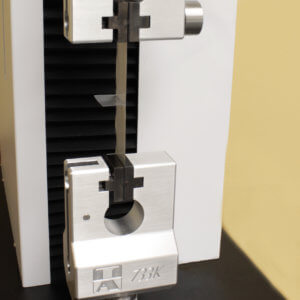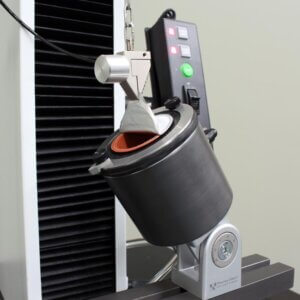NPE 2024 The Plastics Show – Orlando, FL
May 6-10, 2024
Booth S30177
The terms peel and seal strength are sometimes used interchangeably when describing a material’s adhesion properties and the appropriate test methods to accurately test and measure this property. In reality, these terms are distinctly different when it comes to materials testing. Specific testing protocols should be followed to ensure accurate and comparable data.
Peel strength is the measure of the force required to separate two bonded materials such as tape, labels, and plastic films. It can also provide valuable information to evaluate the peel strength for sealed containers, trays, and pouches.
The strength is calculated during a test by pulling the sample at a constant rate of speed and averaging the force data collected over a defined distance or time and dividing this by the unit width of the sample. Results are commonly expressed as N/m or lb/in.
Depending on the material and application, peel testing can simulate actual product use and be tested at various peeling angles.
Peel Strength Data Analysis
Following is a typical graph produced when performing a peel strength test. The primary analysis occurs after the initial slack has been taken up to provide a more accurate representation of the peel strength of the material. Most modern testing instruments will allow the user to adjust the analysis area to eliminate data from the beginning and end of the test.
In addition to calculating the peel strength of the material, software analysis of the data can identify the high force, low force, and standard deviation in the analyzed area. Here are some of the fixtures available for peel testing:
Popular test methods for peel strength analysis include the following:
Seal strength is a useful measure to help predict the final integrity of a package along with the packaging processes’ ability to produce consistent seals, especially those made from thin plastic sheets or similar flexible material. The test is a combination of a tensile test and an adhesive test.
Materials being evaluated for heat seal strength should be prepared using a suitable heat sealer with the provision to control the temperature, dwell time, and pressure of the sealing dies as this can affect the ultimate strength of the heat seal. Specialized equipment is available to perform hot tack testing as the seal strength test should be performed with a specific time interval.
ASTM F88 is the most common test method used to measure and quantify the strength of the seal of flexible materials. The bonded test specimens are prepared to 1” widths with each end clamped in the grips of a tensile tester or similar testing instrument. The test is performed at a constant rate of speed (typically 12 inches/minute) until the bond or material fails.
As some of the force values measured are a result of the sample bending and not entirely due to the strength of the bond, ASTM F88 provides suggested fixtures and techniques to hold the sample at various angles to the pull direction to control this bending force. Examples are shown below:
This is an example of a seal strength test:

Once a test is completed, a visual assessment of the sample should be made to determine the failure type that occurred and noted on the test report. This can include those shown below:
Seal and peel strength measurements can be performed on complete packages, such as cups and trays, to better gauge the adhesion of the lidding material to the formed substrate.

(Examples of a seal test on a cup and tray utilizing specialized test fixtures)